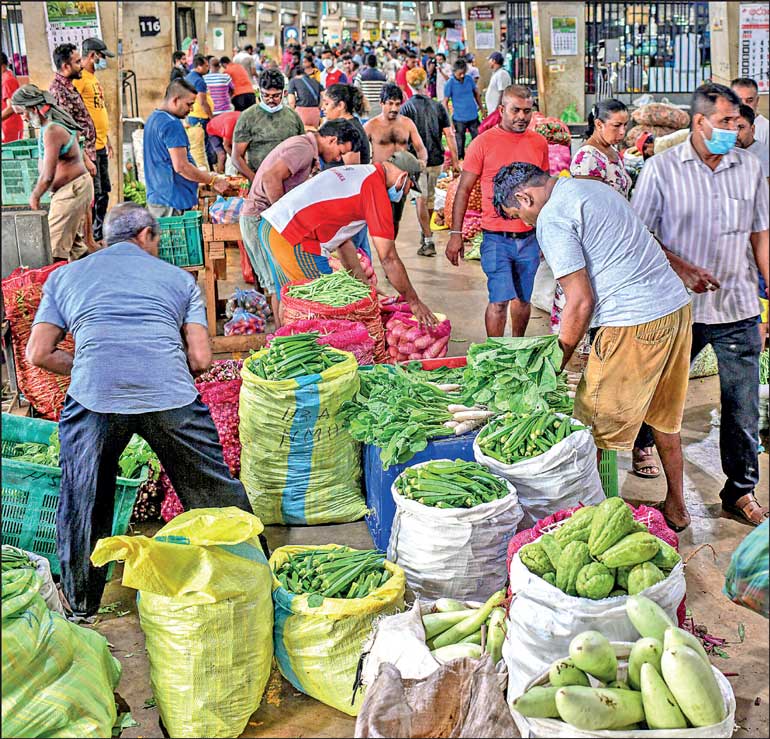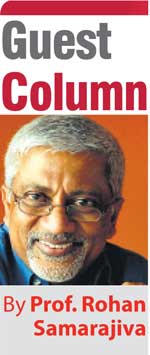Friday Dec 05, 2025
Friday Dec 05, 2025
Tuesday, 11 July 2023 00:01 - - {{hitsCtrl.values.hits}}
 Unlike “sticky” elements such as factionalised elites and group grievances that take time to fix, improvements to the economy can be made relatively quickly
Unlike “sticky” elements such as factionalised elites and group grievances that take time to fix, improvements to the economy can be made relatively quickly
The term resilient that is often used by Sri Lankans to describe their country is almost the opposite of fragile. When one looks at the unhappy history of post-independence Sri Lanka, one could find evidence for resilience of the people, if not the country. Alternatively, one could see the body politic being weakened by the cumulative effects of economic mismanagement, the civil war, the inflaming of ethnic and religious passions, and such. If once resilient, perhaps we no longer are
 In January 2023, I wrote about the sources of the fragility of the Sri Lankan state and predicted that Sri Lanka’s position in the Fragile States Index (FSI) would decline. The 2023 index has been published. Sri Lanka has indeed suffered the worst decline after Ukraine, dropping from 56th place to 30th (though we were much worse back in 2008, in 20th place). In this index, the higher the rank, the greater the fragility. Somalia is ranked 1st and Yemen 2nd. Norway is 179th.
In January 2023, I wrote about the sources of the fragility of the Sri Lankan state and predicted that Sri Lanka’s position in the Fragile States Index (FSI) would decline. The 2023 index has been published. Sri Lanka has indeed suffered the worst decline after Ukraine, dropping from 56th place to 30th (though we were much worse back in 2008, in 20th place). In this index, the higher the rank, the greater the fragility. Somalia is ranked 1st and Yemen 2nd. Norway is 179th.
The overall score of a country is based on 12 indicators, each with equal weight, grouped into four categories: cohesion, economic, political and social. Cohesion includes Security Apparatus, Factionalised Elites, and Group Grievance. Economic is made up of Economic Decline, Uneven Economic Development, and Human Flight and Brain Drain. The political category includes State Legitimacy, Public Services, and Human Rights and Rule of Law. Social is comprised of Demographic Pressures, Refugees and IDPs, and External Intervention.
The Fund for Peace, a Washington DC based organisation, has been publishing these rankings annually since 2005. It is based on a proprietary software called CAST [Conflict Assessment System Tool] using thousands of news reports from open sources as data. For many years researchers have been developing tools such as CAST to predict the political equivalents of natural disasters and assist in risk management. All models and indexes are imperfect. But one can learn something from them.
Causes of increased fragility
The causes of the dramatic change between 2022 and 2023 were not what I had discussed in my January article, where I saw cohesion related factors as the most significant. These were, even in good years, the largest factors affecting Sri Lanka’s standing, especially factionalised elites (9.1/10 in 2022) and group grievances (8.1/10). According to the model, the biggest contributors to the change were directly related to the economic crisis: a 2.8-point increase on the indicator on decline of the economy (from 5.5/10 to 8.3/10 and a 2.5-point increase on external intervention (from 5.4/10 to 7.9/10).
Indirect factors such as factionalised elites remained unchanged at 9.1/10 (still the highest contributor); the group grievance indicator marginally increased from 8.1/10 to 8.4/10. The weakening of state legitimacy was a contributor to the decline, going from 6/10 to 8/10. This too was directly related to the crisis. It is difficult to envisage the state legitimacy indicator improving when a President is chased away. Apparently, the relatively peaceful nature of his departure and the constitutional nature of his replacement has not attenuated the decline.
There is a positive side to this. Unlike “sticky” elements such as factionalised elites and group grievances that take time to fix, improvements to the economy can be made relatively quickly. In 2022, Sri Lanka’s score on the economy was 5.5/10, better than Pakistan’s which was 6.6/10. The economy is on the mend with inflation and interest rates coming down. If debt restructuring is completed soon, the economy will get on a growth path. Even if the score does not get back to 5.5/10, it should surely do better than Pakistan where the economy is on the skids.
If elections are held peacefully in 2024, the state legitimacy indicator should also improve. The activation of parliamentary oversight committees and the apolitical jana sabha at the ground level should also help in this regard. If that happens, Sri Lanka should be able to get out of the “alert” grouping, where it is in the company of Venezuela (29th), Congo (28th), Iraq (27th), Uganda (26th), Lebanon (25th) and others, and into the “high warning” grouping where our peers will be countries such as Nepal (55th), Zambia (48th), and Bangladesh (41st).
Predicting fragility
Fragile means the quality of being easily broken or damaged. Somalia, under Siad Barre (1969-1991) had the appearance of a normal state but when it broke, the pieces could not be put together again. This was the case with Yemen too.
The term resilient that is often used by Sri Lankans to describe their country is almost the opposite of fragile. When one looks at the unhappy history of post-independence Sri Lanka, one could find evidence for resilience of the people, if not the country. Alternatively, one could see the body politic being weakened by the cumulative effects of economic mismanagement, the civil war, the inflaming of ethnic and religious passions, and such. If once resilient, perhaps we no longer are.
Models such as CAST are developed to quantify country risk. To the extent a model is effective in predicting events one could say it is doing its job.
In 2006-2010, it appeared that Sri Lanka was in trouble. The CAST model indicated that the state was fragile, but it did not break. The assessments kept improving from 2011 onward, reaching a high of 56th place in 2022. The puzzle is not that Sri Lanka fell to 30th place in 2023; it is why it was ranked so high in the preceding year.
It appears that the model failed to pick up the alarm signals on the economy that were ringing from 2018 and reached a crescendo in 2020, when the credit ratings were downgraded to a level that made it unable to roll over its debts. There is little value in saying that an economy is in trouble after a country goes bankrupt. True efficacy lies in picking up the signals before the event. So, one must conclude that the model performs poorly in terms of economic aspects.
The failure to reach minimal levels of consensus on how to respond to the crisis suggests that the index is performing less poorly on picking up problems of cohesion, as evidenced by the high scores on factionalised elites and group grievances. Readers may make their own assessments on whether the scores are justified.
The Factionalised Elites indicator (9.1/10 for Sri Lanka in 2022 and 2023) considers “the fragmentation of state institutions along ethnic, class, clan, racial or religious lines, as well as brinksmanship and gridlock between ruling elites. It also factors in the use of nationalistic political rhetoric by ruling elites, often in terms of nationalism, xenophobia, communal irredentism (e.g., a “greater Serbia”) or of communal solidarity (e.g., “ethnic cleansing” or “defending the faith”). In extreme cases, it can be representative of the absence of legitimate leadership widely accepted as representing the entire citizenry. The Factionalised Elites indicator measures power struggles, political competition, political transitions and, where elections occur, will factor in the credibility of electoral processes (or in their absence, the perceived legitimacy of the ruling class).”
The Group Grievance indicator (8.4/10 in 2023) focuses on “divisions and schisms between different groups in society – particularly divisions based on social or political characteristics – and their role in access to services or resources, and inclusion in the political process. Group Grievance may also have a historical component, where aggrieved communal groups cite injustices of the past, sometimes going back centuries, that influence and shape that group’s role in society and relationships with other groups. This history may in turn be shaped by patterns of real or perceived atrocities or “crimes” committed with apparent impunity against communal groups.
Groups may also feel aggrieved because they are denied autonomy, self-determination or political independence to which they believe they are entitled. The indicator also considers where specific groups are singled out by state authorities, or by dominant groups, for persecution or repression, or where there is public scapegoating of groups believed to have acquired wealth, status or power “illegitimately,” which may manifest itself in the emergence of fiery rhetoric, such as through “hate” radio, pamphleteering, and stereotypical or nationalistic political speech.”
The lasting way to become less fragile is to address the major factors of cohesion described above. The quick way out of the cellar is fixing the economy. But the question is whether economic repairs will succeed in the absence of cohesion.